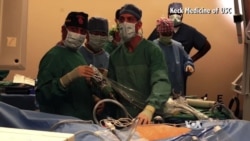There is a new way of killing certain cancer tumors that allows the patient to go home on the same day. Surgeons at the Keck Medical Center of the University of Southern California became the first doctors to use this procedure on a patient with the help of high intensity focused ultrasound, or HIFU, and new robotic technology.
A month ago, doctors found a cancerous tumor in Gary Fradkin’s kidney. It needed to be removed. The 62-year-old windsurfer feared being inactive for weeks after surgery. Doctors told him about a new procedure that would allow him to go home just hours after the operation.
“Summer is almost over. I have got to get whatever wind surfing left I can in the season, so I am happy,” he said.
Clinical trial, HIFU
Fradkin is in a clinical trial that uses high intensity focused ultrasound, or HIFU, to destroy a tumor. Dr. Inderbir Gill says the process starts with an incision about a centimeter wide.
A robotic device then gets into the abdomen, finds the tumor and kills it.
“So that is what is exciting about the case today, is that to our knowledge, for the first time, a kidney tumor has been ablated using high intensity focused ultrasound as monotherapy, without any additional treatment. And allowing us to do this cuts down on the operative time, decreases the blood loss, decreases the chances of complications, preserves kidney function, while killing the tumor and allows the patient to go home the same day,” Gill explains.
Traditionally, patients would have a hospital stay of three to four days after kidney cancer surgery because surgeons would have to cut out the tumor.
“We would stop the blood supply to the kidney. We would cut out the tumor then we would suture and repair the kidney, restore blood supply to the kidney, that is a reasonable undertaking and leads to reasonable amount of blood loss and a significant hospital stay to make sure everything is good before letting him go home and even then tell him “take it easy for a month,” Gill adds.
With high intensity focused ultrasound, Gill says the tumor is not removed. It dissolves slowly over time. “That is what we will be studying closely as to how long it takes for it to go away,” he said.
HIFU may offer new treatment options
Gill says he has identified other patients who can benefit from this procedure. They have to have tumors that are four centimeters or smaller, which is about 10 percent of all kidney tumors. He says he believes in the future HIFU surgery can also be an option for patients with prostate, liver and pancreatic cancers.
“I thought it’s exciting. Dr. Gill keeps pushing the edge. I was happy I was able to get this rather than have to go through a traditional surgery,” stated Fradkin.
Gary Fradkin plans on going back to work as a post-production engineer in the film industry in a few days, and back on the water, surfing with the wind.









